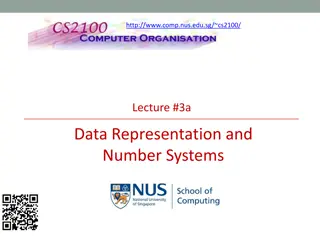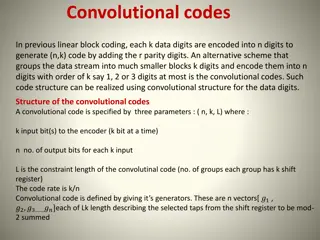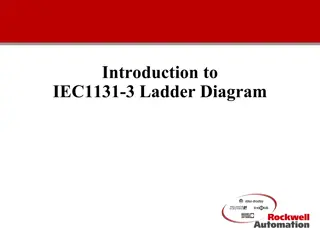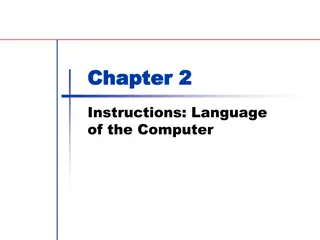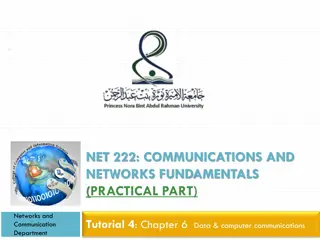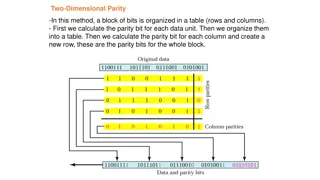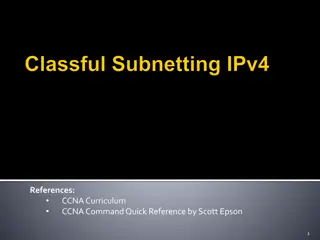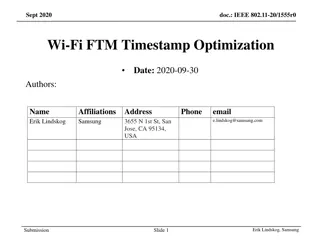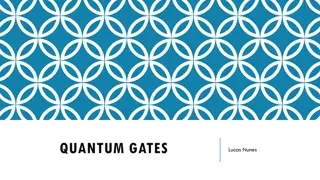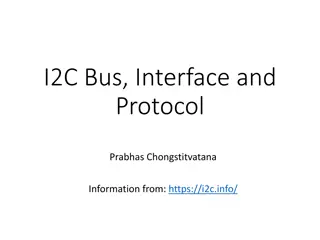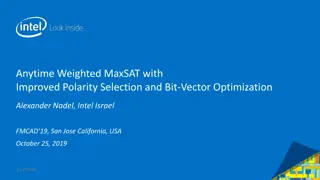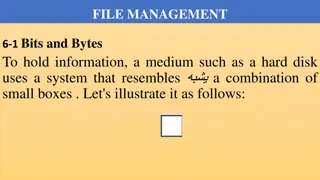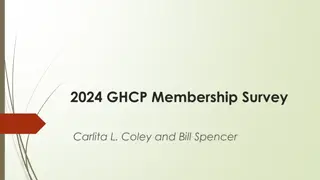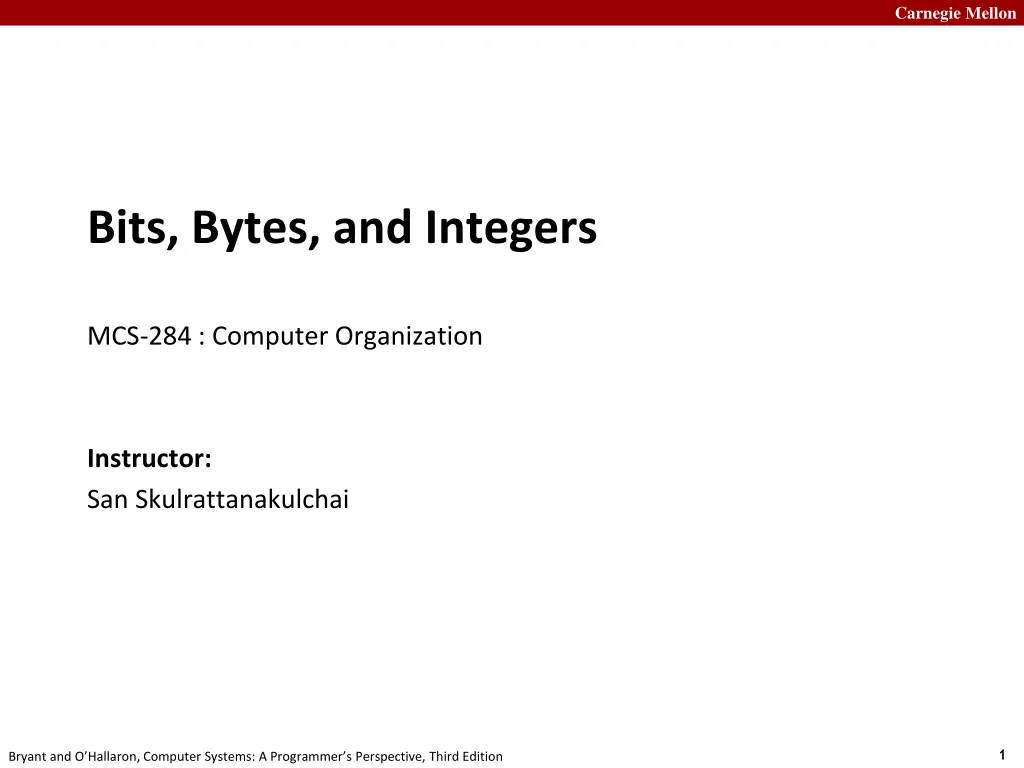
Understanding Computer Organization at Carnegie Mellon: Bits, Bytes, and Integers
Explore the fundamentals of computer organization at Carnegie Mellon, delving into the representation of information as bits, bit-level manipulations, integer representation, and more. Discover the significance of bits in electronic implementation and learn about binary number representation, byte values, and data representations in C. Gain insights into various data types and their typical sizes in a 32-bit and 64-bit system.
Uploaded on | 0 Views
Download Presentation

Please find below an Image/Link to download the presentation.
The content on the website is provided AS IS for your information and personal use only. It may not be sold, licensed, or shared on other websites without obtaining consent from the author. If you encounter any issues during the download, it is possible that the publisher has removed the file from their server.
You are allowed to download the files provided on this website for personal or commercial use, subject to the condition that they are used lawfully. All files are the property of their respective owners.
The content on the website is provided AS IS for your information and personal use only. It may not be sold, licensed, or shared on other websites without obtaining consent from the author.
E N D
Presentation Transcript
Carnegie Mellon Bits, Bytes, and Integers MCS-284 : Computer Organization Instructor: San Skulrattanakulchai 1 Bryant and O Hallaron, Computer Systems: A Programmer s Perspective, Third Edition
Carnegie Mellon Today: Bits, Bytes, and Integers Representing information as bits Bit-level manipulations Integers Representation: unsigned and signed Conversion, casting Expanding, truncating Addition, negation, multiplication, shifting Summary Representations in memory, pointers, strings 2 Bryant and O Hallaron, Computer Systems: A Programmer s Perspective, Third Edition
Carnegie Mellon Everything is bits Each bit is 0 or 1 By encoding/interpreting sets of bits in various ways Computers determine what to do (instructions) and represent and manipulate numbers, sets, strings, etc Why bits? Electronic Implementation Easy to store with bistable elements Reliably transmitted on noisy and inaccurate wires 0 1 0 1.1V 0.9V 0.2V 0.0V 3 Bryant and O Hallaron, Computer Systems: A Programmer s Perspective, Third Edition
Carnegie Mellon For example, can count in binary Base 2 Number Representation Represent 1521310 as 111011011011012 Represent 1.2010as 1.0011001100110011[0011] 2 Represent 1.5213 X 104 as 1.11011011011012 X 213 4 Bryant and O Hallaron, Computer Systems: A Programmer s Perspective, Third Edition
Carnegie Mellon Encoding Byte Values Byte = 8 bits Binary 000000002 to 111111112 Decimal: 010 to 25510 Hexadecimal 0016 to FF16 0 1 2 3 4 5 6 7 8 9 A B C D E F 0 1 2 3 4 5 6 7 8 9 10 11 12 13 14 15 0000 0001 0010 0011 0100 0101 0110 0111 1000 1001 1010 1011 1100 1101 1110 1111 Base 16 number representation Use characters 0 to 9 and A to F Write FA1D37B16 in C as 0xFA1D37B 0xfa1d37b 5 Bryant and O Hallaron, Computer Systems: A Programmer s Perspective, Third Edition
Carnegie Mellon Example Data Representations C Data Type Typical 32-bit Typical 64-bit x86-64 char 1 1 1 short 2 2 2 int 4 4 4 long 4 8 8 float 4 4 4 double 8 8 8 long double 10/16 pointer 4 8 8 6 Bryant and O Hallaron, Computer Systems: A Programmer s Perspective, Third Edition
Carnegie Mellon Today: Bits, Bytes, and Integers Representing information as bits Bit-level manipulations Integers Representation: unsigned and signed Conversion, casting Expanding, truncating Addition, negation, multiplication, shifting Summary Representations in memory, pointers, strings 7 Bryant and O Hallaron, Computer Systems: A Programmer s Perspective, Third Edition
Carnegie Mellon Boolean Algebra Developed by George Boole in 19th Century Algebraic representation of logic Encode True as 1 and False as 0 And Or A&B = 1 when both A=1 and B=1 A|B = 1 when either A=1 or B=1 Not Exclusive-Or (Xor) ~A = 1 when A=0 A^B = 1 when either A=1 or B=1, but not both 8 Bryant and O Hallaron, Computer Systems: A Programmer s Perspective, Third Edition
Carnegie Mellon General Boolean Algebras Operate on Bit Vectors Operations applied bitwise 01101001 & 01010101 01000001 01000001 01101001 | 01010101 01111101 01111101 01101001 ^ 01010101 00111100 00111100 ~ 01010101 10101010 10101010 All of the Properties of Boolean Algebra Apply 9 Bryant and O Hallaron, Computer Systems: A Programmer s Perspective, Third Edition
Carnegie Mellon Example: Representing & Manipulating Sets Representation Width w bit vector represents subsets of {0, , w 1} aj = 1 if j A 01101001 { 0, 3, 5, 6 } 76543210 01010101 { 0, 2, 4, 6 } 76543210 Operations & Intersection | Union ^ Symmetric difference ~ Complement 01000001 01111101 00111100 10101010 { 0, 6 } { 0, 2, 3, 4, 5, 6 } { 2, 3, 4, 5 } { 1, 3, 5, 7 } 10 Bryant and O Hallaron, Computer Systems: A Programmer s Perspective, Third Edition
Carnegie Mellon Bit-Level Operations in C Operations &, |, ~, ^ Available in C Apply to any integral data type long, int, short, char, unsigned View arguments as bit vectors Arguments applied bit-wise Examples (Char data type) ~0x41 0xBE ~010000012 101111102 ~0x00 0xFF ~000000002 111111112 0x69 & 0x55 0x41 011010012 & 010101012 010000012 0x69 | 0x55 0x7D 011010012 | 010101012 011111012 11 Bryant and O Hallaron, Computer Systems: A Programmer s Perspective, Third Edition
Carnegie Mellon Contrast: Logic Operations in C Contrast to Logical Operators &&, ||, ! View 0 as False Anything nonzero as True Always return 0 or 1 Early termination Examples (char data type) !0x41 0x00 !0x00 0x01 !!0x41 0x01 0x69 && 0x55 0x01 0x69 || 0x55 0x01 p && *p (avoids null pointer access) 12 Bryant and O Hallaron, Computer Systems: A Programmer s Perspective, Third Edition
Carnegie Mellon Contrast: Logic Operations in C Contrast to Logical Operators &&, ||, ! View 0 as False Anything nonzero as True Always return 0 or 1 Watch out for && vs. & (and || vs. |) one of the more common oopsies in C programming Early termination Examples (char data type) !0x41 0x00 !0x00 0x01 !!0x41 0x01 0x69 && 0x55 0x01 0x69 || 0x55 0x01 p && *p (avoids null pointer access) 13 Bryant and O Hallaron, Computer Systems: A Programmer s Perspective, Third Edition
Carnegie Mellon Shift Operations Left Shift: x << y Shift bit-vector x left y positions Throw away extra bits on left Argument x 01100010 << 3 00010000 00010000 00010000 Log. >> 2 00011000 00011000 00011000 Fill with 0 s on right Arith. >> 2 00011000 00011000 00011000 Right Shift: x >> y Shift bit-vector x right y positions Argument x 10100010 Throw away extra bits on right Logical shift << 3 00010000 00010000 00010000 Fill with 0 s on left Arithmetic shift Log. >> 2 00101000 00101000 00101000 Arith. >> 2 11101000 11101000 11101000 Replicate most significant bit on left Undefined Behavior Shift amount < 0 or word size 14 Bryant and O Hallaron, Computer Systems: A Programmer s Perspective, Third Edition
Carnegie Mellon Today: Bits, Bytes, and Integers Representing information as bits Bit-level manipulations Integers Representation: unsigned and signed Conversion, casting Expanding, truncating Addition, negation, multiplication, shifting Summary Representations in memory, pointers, strings Summary 15 Bryant and O Hallaron, Computer Systems: A Programmer s Perspective, Third Edition
Carnegie Mellon Encoding Integers Unsigned Two s Complement w 1 w 2 xw 1 2w 1+ xi 2i xi 2i = = B2U(X) B2T(X) i=0 i=0 short int x = 15213; short int y = -15213; Sign Bit C short 2 bytes long x y Decimal 15213 -15213 Hex 3B 6D 00111011 01101101 C4 93 11000100 10010011 Binary Sign Bit For 2 s complement, most significant bit indicates sign 0 for nonnegative 1 for negative 16 Bryant and O Hallaron, Computer Systems: A Programmer s Perspective, Third Edition
Carnegie Mellon Two-complement Encoding Example (Cont.) x = 15213: 00111011 01101101 y = -15213: 11000100 10010011 Weight 15213 1 0 1 1 0 1 1 0 1 1 0 1 1 1 0 0 -15213 1 1 0 0 1 0 0 1 0 0 1 0 0 0 1 1 1 2 4 8 1 0 4 8 0 1 2 0 0 16 32 64 128 256 512 1024 2048 4096 8192 16384 -32768 Sum 16 0 0 128 32 64 0 256 512 0 0 0 1024 2048 4096 8192 0 0 0 0 0 16384 -32768 -15213 15213 17 Bryant and O Hallaron, Computer Systems: A Programmer s Perspective, Third Edition
Carnegie Mellon Numeric Ranges Unsigned Values UMin 000 0 UMax 111 1 Two s Complement Values TMin 100 0 TMax 011 1 = 0 2w 1 = = 2w 1 2w 1 1 = Other Values Minus 1 111 1 Values for W = 16 UMax TMax TMin -1 0 Decimal 65535 32767 -32768 Hex FF FF 11111111 11111111 7F FF 01111111 11111111 80 00 10000000 00000000 FF FF 11111111 11111111 00 00 00000000 00000000 Binary -1 0 18 Bryant and O Hallaron, Computer Systems: A Programmer s Perspective, Third Edition
Carnegie Mellon Values for Different Word Sizes W 8 255 127 -128 16 65,535 32,767 -32,768 32 64 UMax TMax TMin 4,294,967,295 2,147,483,647 -2,147,483,648 18,446,744,073,709,551,615 9,223,372,036,854,775,807 -9,223,372,036,854,775,808 Observations |TMin | = C Programming #include <limits.h> Declares constants, e.g., ULONG_MAX LONG_MAX LONG_MIN Values platform specific TMax + 1 Asymmetric range UMax = 2 * TMax + 1 19 Bryant and O Hallaron, Computer Systems: A Programmer s Perspective, Third Edition
Carnegie Mellon Unsigned & Signed Numeric Values Equivalence Same encodings for nonnegative values X B2U(X) 0 1 2 3 4 5 6 7 B2T(X) 0 1 2 3 4 5 6 7 8 7 6 5 4 3 2 1 0000 0001 0010 0011 0100 0101 0110 0111 1000 1001 1010 1011 1100 1101 1110 1111 Uniqueness Every bit pattern represents unique integer value Each representable integer has unique bit encoding Can Invert Mappings U2B(x) = B2U-1(x) 8 9 10 11 12 13 14 15 Bit pattern for unsigned integer T2B(x) = B2T-1(x) Bit pattern for two s comp integer 20 Bryant and O Hallaron, Computer Systems: A Programmer s Perspective, Third Edition
Carnegie Mellon Today: Bits, Bytes, and Integers Representing information as bits Bit-level manipulations Integers Representation: unsigned and signed Conversion, casting Expanding, truncating Addition, negation, multiplication, shifting Summary Representations in memory, pointers, strings 21 Bryant and O Hallaron, Computer Systems: A Programmer s Perspective, Third Edition
Carnegie Mellon Mapping Between Signed & Unsigned Unsigned Two s Complement T2U x ux T2B B2U X Maintain Same Bit Pattern Two s Complement x Unsigned U2T ux U2B B2T X Maintain Same Bit Pattern Mappings between unsigned and two s complement numbers: Keep bit representations and reinterpret 22 Bryant and O Hallaron, Computer Systems: A Programmer s Perspective, Third Edition
Carnegie Mellon Mapping Signed Unsigned Bits Signed Unsigned 0000 0001 0010 0011 0100 0101 0110 0111 1000 1001 1010 1011 1100 1101 1110 1111 0 1 2 3 4 5 6 7 0 1 2 3 4 5 6 7 8 9 T2U U2T -8 -7 -6 -5 -4 -3 -2 -1 10 11 12 13 14 15 23 Bryant and O Hallaron, Computer Systems: A Programmer s Perspective, Third Edition
Carnegie Mellon Mapping Signed Unsigned Bits Signed Unsigned 0000 0001 0010 0011 0100 0101 0110 0111 1000 1001 1010 1011 1100 1101 1110 1111 0 1 2 3 4 5 6 7 0 1 2 3 4 5 6 7 8 9 = -8 -7 -6 -5 -4 -3 -2 -1 10 11 12 13 14 15 +/- 16 24 Bryant and O Hallaron, Computer Systems: A Programmer s Perspective, Third Edition
Carnegie Mellon Relation between Signed & Unsigned Unsigned Two s Complement T2U x ux T2B B2U X Maintain Same Bit Pattern w 1 0 ux x + + + - + + + + + + + + Large negative weight becomes Large positive weight 25 Bryant and O Hallaron, Computer Systems: A Programmer s Perspective, Third Edition
Carnegie Mellon Conversion Visualized 2 s Comp. Ordering Inversion Negative Big Positive Unsigned UMax UMax 1 TMax + 1 Unsigned Range TMax TMax 2 s Complement 0 0 Range 1 2 TMin 26 Bryant and O Hallaron, Computer Systems: A Programmer s Perspective, Third Edition
Carnegie Mellon Signed vs. Unsigned in C Constants By default are considered to be signed integers Unsigned if have U as suffix 0U, 4294967259U Casting Explicit casting between signed & unsigned same as U2T and T2U int tx, ty; unsigned ux, uy; tx = (int) ux; uy = (unsigned) ty; Implicit casting also occurs via assignments and procedure calls tx = ux; uy = ty; 27 Bryant and O Hallaron, Computer Systems: A Programmer s Perspective, Third Edition
Carnegie Mellon Casting Surprises Expression Evaluation If there is a mix of unsigned and signed in single expression, signed values implicitly cast to unsigned Including comparison operations <, >, ==, <=, >= Examples for W = 32: TMIN = -2,147,483,648 , TMAX = 2,147,483,647 Constant2 0 0U -1 0 -1 0U 2147483647 -2147483647-1 2147483647U -2147483647-1 -1 -2 (unsigned)-1 -2 2147483647 2147483648U Constant1 Relation Evaluation 0 0U 0 0U -2147483648 -2147483648 -2 -2 2147483648U (int) 2147483648U (int) 2147483648U == < > > < > > < > unsigned signed unsigned signed unsigned signed unsigned unsigned signed -1 -1 2147483647 2147483647U -1 (unsigned) -1 2147483647 2147483647 2147483647 28 Bryant and O Hallaron, Computer Systems: A Programmer s Perspective, Third Edition
Carnegie Mellon Summary Casting Signed Unsigned: Basic Rules Bit pattern is maintained But reinterpreted Can have unexpected effects: adding or subtracting 2w Expression containing signed and unsigned int int is cast to unsigned!! 29 Bryant and O Hallaron, Computer Systems: A Programmer s Perspective, Third Edition
Carnegie Mellon Today: Bits, Bytes, and Integers Representing information as bits Bit-level manipulations Integers Representation: unsigned and signed Conversion, casting Expanding, truncating Addition, negation, multiplication, shifting Summary Representations in memory, pointers, strings 30 Bryant and O Hallaron, Computer Systems: A Programmer s Perspective, Third Edition
Carnegie Mellon Sign Extension Task: Given w-bit signed integer x Convert it to w+k-bit integer with same value Rule: Make k copies of sign bit: X = xw 1 , , xw 1 , xw 1 , xw 2 , , x0 w k copies of MSB X X k w 31 Bryant and O Hallaron, Computer Systems: A Programmer s Perspective, Third Edition
Carnegie Mellon Sign Extension Example short int x = 15213; int ix = (int) x; short int y = -15213; int iy = (int) y; Decimal 15213 15213 -15213 -15213 Hex Binary x ix y iy 3B 6D 00111011 01101101 00 00 3B 6D 00000000 00000000 00111011 01101101 C4 93 11000100 10010011 FF FF C4 93 11111111 11111111 11000100 10010011 Converting from smaller to larger integer data type C automatically performs sign extension 32 Bryant and O Hallaron, Computer Systems: A Programmer s Perspective, Third Edition
Carnegie Mellon Summary: Expanding, Truncating: Basic Rules Expanding (e.g., short int to int) Unsigned: zeros added Signed: sign extension Both yield expected result Truncating (e.g., unsigned to unsigned short) Unsigned/signed: bits are truncated Result reinterpreted Unsigned: mod operation Signed: similar to mod For small numbers yields expected behavior 33 Bryant and O Hallaron, Computer Systems: A Programmer s Perspective, Third Edition
Carnegie Mellon Today: Bits, Bytes, and Integers Representing information as bits Bit-level manipulations Integers Representation: unsigned and signed Conversion, casting Expanding, truncating Addition, negation, multiplication, shifting Representations in memory, pointers, strings Summary 34 Bryant and O Hallaron, Computer Systems: A Programmer s Perspective, Third Edition
Carnegie Mellon Unsigned Addition u v Operands: w bits + True Sum: w+1 bits u + v UAddw(u , v) Discard Carry: w bits Standard Addition Function Ignores carry output Implements Modular Arithmetic s = UAddw(u , v) = u + v mod 2w 35 Bryant and O Hallaron, Computer Systems: A Programmer s Perspective, Third Edition
Carnegie Mellon Visualizing (Mathematical) Integer Addition Add4(u , v) Integer Addition 4-bit integers u, v Compute true sum Add4(u , v) Values increase linearly with u and v Forms planar surface Integer Addition 32 28 24 20 16 14 12 12 10 8 8 4 6 v 0 4 0 2 u 2 4 6 8 0 10 12 14 36 Bryant and O Hallaron, Computer Systems: A Programmer s Perspective, Third Edition
Carnegie Mellon Visualizing Unsigned Addition Overflow Wraps Around If true sum 2w At most once UAdd4(u , v) 16 True Sum 14 2w+1 12 Overflow 10 8 14 2w 6 12 10 4 8 v 2 6 0 0 4 Modular Sum 0 u 2 2 4 6 8 0 10 12 14 37 Bryant and O Hallaron, Computer Systems: A Programmer s Perspective, Third Edition
Carnegie Mellon Two s Complement Addition u v Operands: w bits + True Sum: w+1 bits u + v TAddw(u , v) Discard Carry: w bits TAdd and UAdd have Identical Bit-Level Behavior Signed vs. unsigned addition in C: int s, t, u, v; s = (int) ((unsigned) u + (unsigned) v); t = u + v Will gives == t 38 Bryant and O Hallaron, Computer Systems: A Programmer s Perspective, Third Edition
Carnegie Mellon TAdd Overflow True Sum Functionality True sum requires w+1 bits Drop off MSB Treat remaining bits as 2 s comp. integer 0111 1 2w 1 PosOver TAdd Result 0100 0 2w 1 1 011 1 0000 0 0 000 0 1011 1 2w 1 100 0 NegOver 1000 0 2w 39 Bryant and O Hallaron, Computer Systems: A Programmer s Perspective, Third Edition
Carnegie Mellon Visualizing 2 s Complement Addition NegOver Values 4-bit two s comp. Range from -8 to +7 TAdd4(u , v) Wraps Around If sum 2w 1 8 6 4 Becomes negative 2 At most once If sum < 2w 1 0 6 -2 4 2 -4 0 -6 Becomes positive -2 -8 v -4 -8 At most once -6 -6 -4 -2 0 -8 2 4 PosOver u 6 40 Bryant and O Hallaron, Computer Systems: A Programmer s Perspective, Third Edition
Carnegie Mellon Multiplication Goal: Computing Product of w-bit numbers x, y Either signed or unsigned But, exact results can be bigger than w bits Unsigned: up to 2w bits Result range: 0 x * y (2w 1) 2 = 22w 2w+1 + 1 Two s complement min (negative): Up to 2w-1 bits Result range: x * y ( 2w 1)*(2w 1 1) = 22w 2 + 2w 1 Two s complement max (positive): Up to 2w bits, but only for (TMinw)2 Result range: x * y ( 2w 1) 2 = 22w 2 So, maintaining exact results would need to keep expanding word size with each product computed is done in software, if needed e.g., by arbitrary precision arithmetic packages 41 Bryant and O Hallaron, Computer Systems: A Programmer s Perspective, Third Edition
Carnegie Mellon Unsigned Multiplication in C u v Operands: w bits * u v True Product: 2*w bits UMultw(u , v) Discard w bits: w bits Standard Multiplication Function Ignores high order w bits Implements Modular Arithmetic UMultw(u , v) = u v mod 2w 42 Bryant and O Hallaron, Computer Systems: A Programmer s Perspective, Third Edition
Carnegie Mellon Signed Multiplication in C u v Operands: w bits * u v True Product: 2*w bits TMultw(u , v) Discard w bits: w bits Standard Multiplication Function Ignores high order w bits Some of which are different for signed vs. unsigned multiplication Lower bits are the same 43 Bryant and O Hallaron, Computer Systems: A Programmer s Perspective, Third Edition
Carnegie Mellon Power-of-2 Multiply with Shift Operation u << kgives u * 2k Both signed and unsigned k u 2k Operands: w bits * 0 0 1 0 0 0 u 2k True Product: w+k bits 0 0 0 UMultw(u , 2k) TMultw(u , 2k) Discard k bits: w bits 0 0 0 Examples u << 3 (u << 5) (u << 3) == Most machines shift and add faster than multiply == u * 8 u * 24 Compiler generates this code automatically 44 Bryant and O Hallaron, Computer Systems: A Programmer s Perspective, Third Edition
Carnegie Mellon Unsigned Power-of-2 Divide with Shift Quotient of Unsigned by Power of 2 u >> kgives u / 2k Uses logical shift k u 2k Binary Point Operands: / 0 0 1 0 0 0 u / 2k . 0 0 0 0 Division: u / 2k 0 0 0 0 Result: x x >> 1 x >> 4 x >> 8 Division 15213 7606.5 950.8125 59.4257813 Computed 15213 Hex 3B 6D 00111011 01101101 1D B6 00011101 10110110 03 B6 00000011 10110110 00 3B 00000000 00111011 Binary 7606 950 59 45 Bryant and O Hallaron, Computer Systems: A Programmer s Perspective, Third Edition
Carnegie Mellon Today: Bits, Bytes, and Integers Representing information as bits Bit-level manipulations Integers Representation: unsigned and signed Conversion, casting Expanding, truncating Addition, negation, multiplication, shifting Summary Representations in memory, pointers, strings 46 Bryant and O Hallaron, Computer Systems: A Programmer s Perspective, Third Edition
Carnegie Mellon Arithmetic: Basic Rules Addition: Unsigned/signed: Normal addition followed by truncate, same operation on bit level Unsigned: addition mod 2w Mathematical addition + possible subtraction of 2w Signed: modified addition mod 2w (result in proper range) Mathematical addition + possible addition or subtraction of 2w Multiplication: Unsigned/signed: Normal multiplication followed by truncate, same operation on bit level Unsigned: multiplication mod 2w Signed: modified multiplication mod 2w (result in proper range) 47 Bryant and O Hallaron, Computer Systems: A Programmer s Perspective, Third Edition
Carnegie Mellon Why Should I Use Unsigned? Don t use without understanding implications Easy to make mistakes unsigned i; for (i = cnt-2; i >= 0; i--) a[i] += a[i+1]; Can be very subtle #define DELTA sizeof(int) int i; for (i = CNT; i-DELTA >= 0; i-= DELTA) . . . 48 Bryant and O Hallaron, Computer Systems: A Programmer s Perspective, Third Edition
Carnegie Mellon Counting Down with Unsigned Proper way to use unsigned as loop index unsigned i; for (i = cnt-2; i < cnt; i--) a[i] += a[i+1]; See Robert Seacord, Secure Coding in C and C++ C Standard guarantees that unsigned addition will behave like modular arithmetic 0 1 UMax Even better size_t i; for (i = cnt-2; i < cnt; i--) a[i] += a[i+1]; Data type size_t defined as unsigned value with length = word size Code will work even if cnt = UMax What if cnt is signed and < 0? 49 Bryant and O Hallaron, Computer Systems: A Programmer s Perspective, Third Edition
Carnegie Mellon Why Should I Use Unsigned? (cont.) Do Use When Performing Modular Arithmetic Multiprecision arithmetic Do Use When Using Bits to Represent Sets Logical right shift, no sign extension 50 Bryant and O Hallaron, Computer Systems: A Programmer s Perspective, Third Edition



